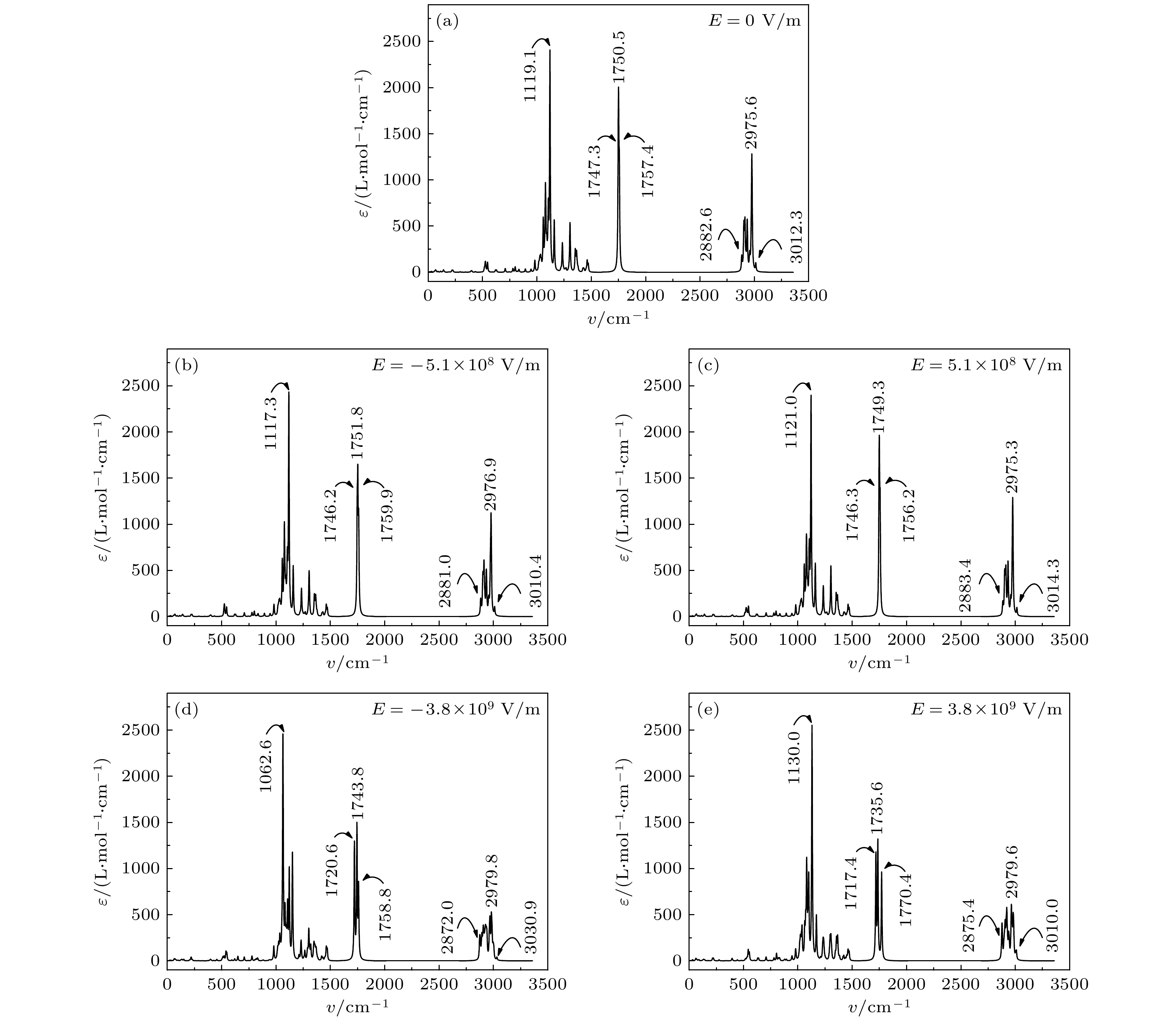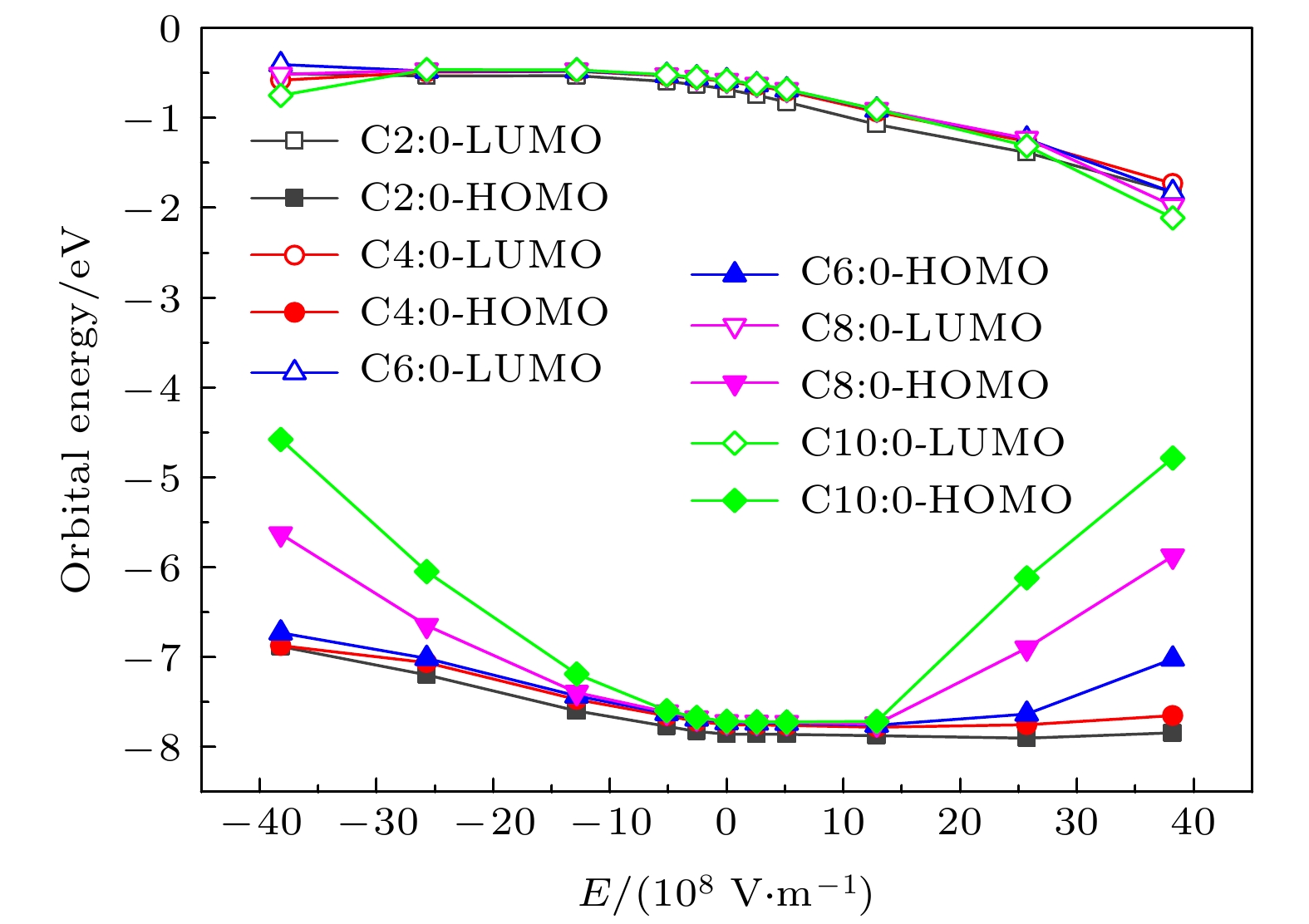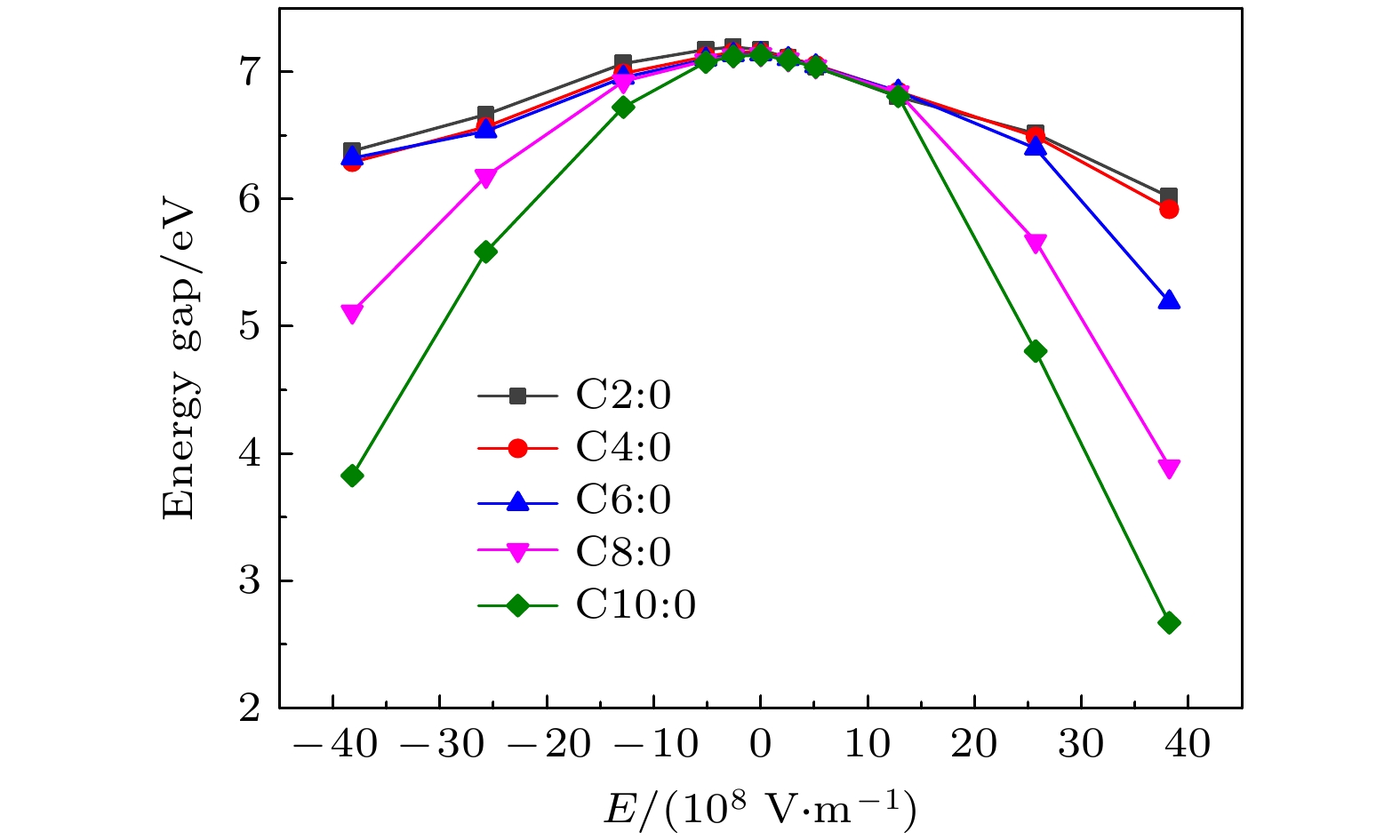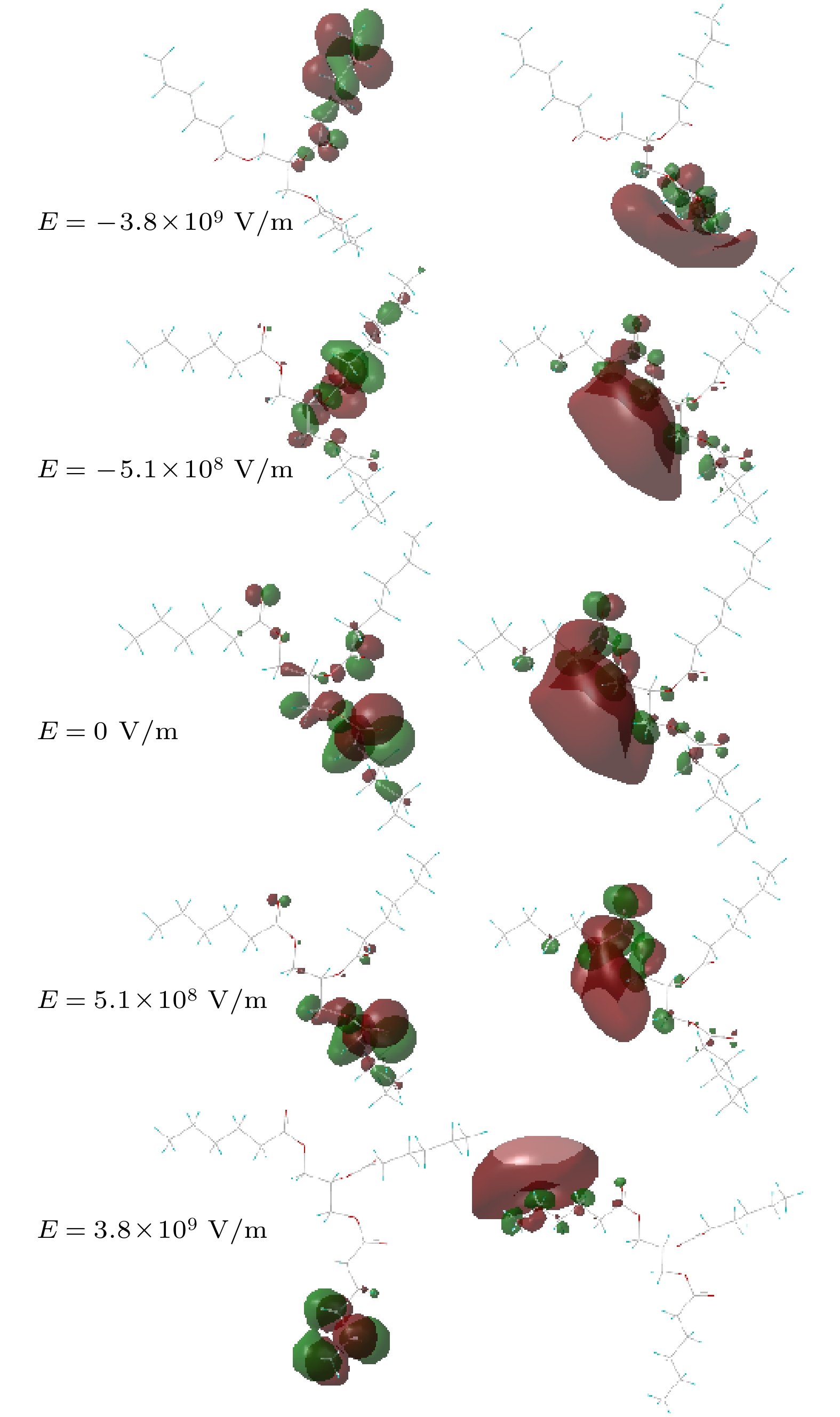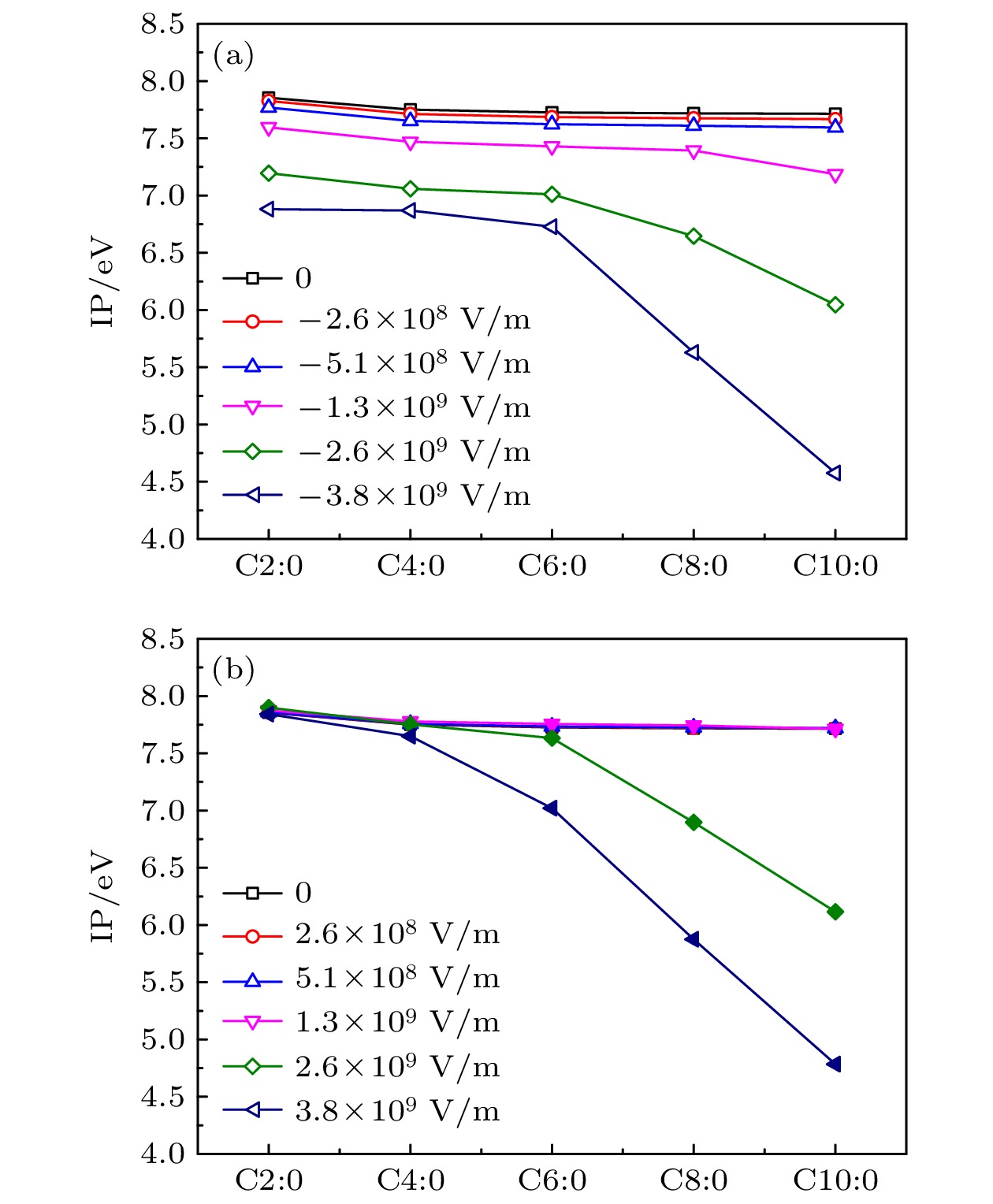-
Short-medium chain saturated triglyceride is a low viscosity and degradable liquid dielectric material, which has potential applications in the field of transformer internal insulation. In this paper, the molecular properties of short-medium chain saturated triglycerides under the action of electric field are studied by using density functional theory and time-dependent density functional theory. The results show that the molecular bond length is obviously dependent on the electric field intensity, which is consistent with the shift of the infrared wave number peak. Under the same electric field, with the increase of the length of carbon chain, the dipole moment and polarity of the molecule increase correspondingly. When the electric field intensity is 109 V/m, the energy of the highest occupied molecular orbital of tricaprylin and tricaprin increases obviously, and the ionization potential decreases sharply. The difference in excitation characteristic between molecules is small, and the decrease of excitation energy is much smaller than that of ionization potential under the same electric field. The results are helpful in improving the understanding of discharge mechanism in ester dielectric, and provide the theoretical support for the performance improvement of natural ester insulating oil.
-
Keywords:
- triglyceride /
- density functional theory /
- ionization potential /
- excited state
[1] Dong L, Zhong X, He J, Zhang L, Huang X 2016 Clin. Nutr. 35 399
 Google Scholar
Google Scholar
[2] Heerdt B G, Houston M A, Anthony G M, Augenlicht L H 1999 Cancer Res. 59 1584
[3] Fofana I 2013 IEEE Electr. Insul. Mag. 29 13
 Google Scholar
Google Scholar
[4] Wedin P 2014 IEEE Electr. Insul. Mag. 30 20
 Google Scholar
Google Scholar
[5] Thakur S, Sarathi R, Danikas M G 2019 Electr. Eng. 101 1007
 Google Scholar
Google Scholar
[6] Dombek G, Gielniak J 2018 IEEE Trans. Dielectr. Electr. Insul. 5 1846
 Google Scholar
Google Scholar
[7] Trnka P, Hornak J, Prosr P, Michal O, Wang F 2020 IEEE Access 8 61989
 Google Scholar
Google Scholar
[8] Rozga P 2016 IET Sci. Meas. Technol. 10 665
 Google Scholar
Google Scholar
[9] Rodríguez M, Galán M 1995 Chem. Eng. J. 60 117
 Google Scholar
Google Scholar
[10] Tobazcon R 1994 IEEE Trans. Dielectr. Electr. Insul. 1 1132
 Google Scholar
Google Scholar
[11] Beroual A, Zahn M, Badent A, Kist K, Torshin Y 1998 IEEE Electr. Insul. Mag. 14 6
 Google Scholar
Google Scholar
[12] Rozga P 2015 IEEE Trans. Dielectr. Electr. Insul. 22 2754
 Google Scholar
Google Scholar
[13] Li J, Wang Y C, Wang F P, Liang S N, Lin X, Chen X P, Zhou J H 2017 Phys. Lett. A 381 3732
 Google Scholar
Google Scholar
[14] Wang Y C, Wang F P, Li J, Liang S N, Zhou J H 2018 Energies 11 523
 Google Scholar
Google Scholar
[15] Smalo H S, Hestad Ø, Ingebrigtsen S, Åstrand P O 2011 J. Appl. Phys. 109 073306
 Google Scholar
Google Scholar
[16] Wang Y C, Wang F P, Li J, Huang Z Y, Liang S N, Zhou J H 2017 Energies 10 510
 Google Scholar
Google Scholar
[17] 黄多辉, 王藩侯, 程晓洪, 万明杰 蒋刚 2011 物理学报 60 123101
 Google Scholar
Google Scholar
Huang D H, Wang P H, Cheng X H, Wang M J, Jiang G 2011 Acta Phys. Sin. 60 123101
 Google Scholar
Google Scholar
[18] Xu G L, Liu X F, Xie H X, Zhang X Z, Liu Y F 2010 Chin. Phys. B 19 113201
 Google Scholar
Google Scholar
[19] 曹欣伟, 任杨, 刘慧, 李姝丽 2014 物理学报 63 043101
 Google Scholar
Google Scholar
Cao X W, Ren Y, Liu H, Li S L 2014 Acta Phys. Sin. 63 043101
 Google Scholar
Google Scholar
[20] Xu G L, Xie H X, Wei Y, Zhang X Z Liu Y F 2012 Chin. Phys. B 21 153
 Google Scholar
Google Scholar
[21] Grozema F C, Telesca R, Jonkman H T, Siebbeles L, Snijders J G 2001 J. Chem. Phys. 115 10014
 Google Scholar
Google Scholar
[22] 杜建宾, 武德起, 唐延林, 隆正文 2015 物理学报 64 073101
 Google Scholar
Google Scholar
Du J B, Wu D Q, Tang Y L, Long Z W 2015 Acta Phys. Sin. 64 073101
 Google Scholar
Google Scholar
[23] 袁伟 2013 硕士学位论文 (新乡: 河南师范大学)
Yuan W 2013 M. S. Thesis (Xinxiang: Henan Normal University) (in Chinese)
[24] NIST Computational Chemistry Comparison and Benchmark Data Basehttp://cccbdb.nist.gov/vibscalejust.asp [2020-8-1]
[25] NIST Standard Reference Database 69: Chemistry WebBook https://webbook.nist.gov/chemistry/ [2018-10-1]
[26] 凌智钢, 唐延林, 李涛, 李玉鹏, 魏晓楠 2013 物理学报 62 223102
 Google Scholar
Google Scholar
Ling Z G, Tang Y L, Li T, Li Y P, Wei X N 2013 Acta Phys. Sin. 62 223102
 Google Scholar
Google Scholar
[27] 李晓虎 2006 博士学位论文 (重庆: 重庆大学)
Li X H 2006 Ph. D. Dissertation (Chongqing: Chongqing University) (in Chinese)
[28] 李世雄, 吴永刚, 令狐荣锋, 孙光宇, 张正平 秦水介 2015 物理学报 64 043101
 Google Scholar
Google Scholar
Li S X, Wu Y G, Linghu R F, Sun G Y, Zhang Z P, Qing S J 2015 Acta Phys. Sin. 64 043101
 Google Scholar
Google Scholar
[29] Li J, Liu X Y, Zhu Z H, Sheng Y 2012 Chin. Phys. B 21 033101
 Google Scholar
Google Scholar
[30] Lu T, Chen F W 2012 J. Comput. Chem. 33 580
 Google Scholar
Google Scholar
[31] Smalo H S, Astrand P O Ingebrigtsen S 2010 IEEE Trans. Dielectr. Electr. Insul. 17 733
 Google Scholar
Google Scholar
[32] Jadidian J, Zahn M, Lavesson N, Widlund O, Borg K 2012 IEEE Trans. Plasma Sci. 40 909
 Google Scholar
Google Scholar
-
表 1 不同计算方法的比较
Table 1. Comparison of different calculation methods
方法 甘油
三酯波数 v/ cm–1 C—O—O C=O C—H C2:0 1235.8 1816.3 2938.4 C4:0 1185.9 1809.5 2938.3 HF/631+
G*/0.90C6:0 1162 1809.2 2926.4 C8:0 1179.5 1809.1 2926.2 C10:0 1160.2 1808.9 2908.9 C2:0 1173.9 1787.1 2602.1 C4:0 1131.2 1778.3 2993.7 B3LYP/631G*/0.96 C6:0 1126.8 1778.2 2983.1 C8:0 1125.2 1778.2 2981.7 C10:0 1089.3 1778.2 2907.7 C2:0 1181.6 1756.8 2956.7 C4:0 1123.3 1750.7 2987.5 B3LYP/631+G*/0.96 C6:0 1119.1 1750.5 2975.6 C8:0 1117.6 1750.4 2940.5 C10:0 1116.5 1750.4 2943.9 C2:0 1164.1 1751.3 2936.3 C4:0 1107.6 1745.4 2966.1 B3LYP/6311++G**/0.96 C6:0 1104.2 1745.1 2959.5 C8:0 1103 1745 2895.9 C10:0 1102.3 1745 2929.9 C2:0 1208.0 1738.6 2950.0 实验值 C4:0 1159.0 1736.5 2962.5 C6:0 1159.8 1744.4 2950.4 C8:0 1155.5 1747.5 2958.3 C10:0 − − − 表 2 电场下C6∶0分子的键长
Table 2. Bond length of C6∶0 molecule under electric field.
E/(108 V·m–1) 2C—9O/Å 12C—9O/Å 12C=13O/Å 5C—10O/Å 14C—10O/Å 14C = 15O/Å 1C—11O/Å 16C=17O/Å –38 1.435 1.389 1.205 1.434 1.379 1.209 1.438 1.214 –25 1.434 1.388 1.207 1.433 1.379 1.207 1.432 1.211 –13 1.434 1.384 1.207 1.431 1.376 1.207 1.430 1.209 –5.1 1.434 1.381 1.207 1.431 1.373 1.206 1.429 1.208 –2.6 1.434 1.380 1.207 1.432 1.372 1.208 1.428 1.208 0 1.434 1.380 1.207 1.433 1.371 1.207 1.428 1.207 2.6 1.434 1.379 1.207 1.433 1.370 1.208 1.428 1.207 5.1 1.434 1.378 1.207 1.434 1.369 1.208 1.428 1.207 13 1.435 1.375 1.208 1.436 1.366 1.210 1.428 1.206 25 1.434 1.373 1.209 1.439 1.360 1.213 1.428 1.205 38 1.434 1.370 1.211 1.443 1.355 1.216 1.425 1.203 表 3 电场下C6∶0分子的前线轨道组分
Table 3. The frontier orbital composition of C6∶0 molecule under electric field.
E/(108 V·m–1) Composition of the HOMO and LUMO (>3%) –38 HOMO 5C∶3.73, 12C∶4.49, 37C∶3.35, 40C∶11.88, 43H∶4.08, 45C∶18.02, 46C∶13.24, 47H∶4.2, 48H∶10.08, 50H∶6.99 LUMO 1C∶18.58, 2C∶18.88, 5C∶31.84, 18C∶6.56, 19C∶10.27, 22C∶6.87 –5.1 HOMO 2C∶3.07, 12C∶3.36, 13O∶34.35, 36C∶25.08, 37C∶5.25, 40C∶4.97 LUMO 1C∶7.12, 2C∶7.25, 14C∶5.28, 18C∶25.35, 19C∶33.40, 27C∶6.48, 28C3.29, 31C∶3.17 0 HOMO 2C∶5.86, 5C∶5.03, 11O∶7.80, 17O∶31.35, 18C∶17.39, 19C∶5.15, 22C∶5.58 LUMO 1C∶5.77, 2C∶6.75, 14C∶4.68, 18C∶26.92, 19C∶32.22, 27C∶7.36, 28C∶4.81, 31C∶3.87 5.1 HOMO 2C∶5.62, 5C∶4.92, 11O∶8.19, 12C∶3.31, 16C∶3.17, 17O∶32.67, 18C∶17.61, 19C∶5.21, 22C∶5.88 LUMO 1C∶8.10, 2C∶9.33, 14C∶3.39, 18C∶7.20, 19C∶29.10, 27C∶6.93, 28C∶4.89, 31C∶4.08 38 HOMO 1C∶15.52, 2C∶31.37, 18C∶5.46, 19C∶7.80, 52C∶8.47, 53C∶6.22, 54H∶4.66, 55H∶5.03, 57H∶3.53, 58H∶3.32 LUMO 27C∶9.74, 28C∶26.00, 31C∶33.47, 59C∶26.02 表 4 电场下分子的激发态
Table 4. The molecular excited state under electric field.
分子 E /(108 V·m–1) m = 1 m = 2 m = 3 m = 4 m = 5 m = 6 m = 7 m = 8 m = 9 0 Eex /eV 5.6219 5.6422 5.6657 6.6449 6.6683 6.7503 6.7754 6.8532 6.8874 λ /nm 220.54 219.74 218.83 186.59 185.93 183.67 182.99 180.91 180.02 f 0.0009 0.0009 0.0004 0.0056 0.0015 0.0177 0.0096 0.0019 0.0032 5.1 Eex /eV 5.6149 5.6418 5.6619 6.6358 6.6848 6.7356 6.7626 6.8506 6.8776 C2∶0 λ /nm 220.81 219.76 218.98 186.84 185.47 184.07 183.34 180.98 180.27 f 0.0009 0.0009 0.0005 0.0071 0.0009 0.0169 0.0098 0.0041 0.0022 26 Eex /eV 5.5859 5.6366 5.643 6.3958 6.4734 6.5507 6.7110 6.8013 6.8396 λ /nm 221.96 219.96 219.71 193.85 191.53 189.27 184.75 182.30 181.27 f 0.0008 0.0009 0.0004 0.0040 0.0024 0.0070 0.0005 0.0227 0.0023 0 Eex /eV 5.6609 5.6751 5.7014 6.6073 6.6248 6.7205 6.7478 6.8553 6.8990 λ /nm 219.02 218.47 217.46 187.65 187.15 184.49 183.74 180.86 179.71 f 0.0004 0.0005 0.0002 0.0017 0.0115 0.0113 0.0004 0.0013 0.0055 5.1 Eex /eV 5.6551 5.6747 5.6991 6.6070 6.6271 6.7076 6.7391 6.8510 6.8983 C6∶0 λ /nm 219.24 218.49 217.55 187.66 187.09 184.84 183.98 180.97 179.73 f 0.0004 0.0005 0.0002 0.0127 0.0006 0.0110 0.0002 0.0051 0.0017 26 Eex /eV 5.6314 5.6697 5.6808 6.3806 6.4593 6.5178 6.7284 6.7854 6.8576 λ /nm 220.17 218.68 218.25 194.31 191.95 190.22 184.27 182.72 180.80 f 0.0004 0.0004 0.0001 0.0062 0.0011 0.0037 0.0004 0.0123 0.0011 0 Eex /eV 5.6594 5.6735 5.7005 6.6005 6.6186 6.7133 6.7432 6.8516 6.8955 λ /nm 219.08 218.53 217.5 187.84 187.33 184.68 183.87 180.96 179.80 f 0.0004 0.0005 0.0002 0.0017 0.0124 0.0117 0.0004 0.0014 0.0056 5.1 Eex /eV 5.6538 5.6734 5.6984 6.5991 6.6206 6.7002 6.7336 6.8443 6.8952 C10∶0 λ /nm 219.29 218.54 217.58 187.88 187.27 185.05 184.13 181.15 179.81 f 0.0004 0.0005 0.0002 0.0136 0.0005 0.0115 0.0002 0.0052 0.0019 26 Eex /eV 5.6303 5.6676 5.6812 6.3752 6.4561 6.5099 6.7246 6.7745 6.8546 λ /nm 220.21 218.76 218.24 194.48 192.04 190.45 184.37 183.01 180.88 f 0.0004 0.0004 0.0001 0.0067 0.0010 0.0040 0.0005 0.0132 0.0010 -
[1] Dong L, Zhong X, He J, Zhang L, Huang X 2016 Clin. Nutr. 35 399
 Google Scholar
Google Scholar
[2] Heerdt B G, Houston M A, Anthony G M, Augenlicht L H 1999 Cancer Res. 59 1584
[3] Fofana I 2013 IEEE Electr. Insul. Mag. 29 13
 Google Scholar
Google Scholar
[4] Wedin P 2014 IEEE Electr. Insul. Mag. 30 20
 Google Scholar
Google Scholar
[5] Thakur S, Sarathi R, Danikas M G 2019 Electr. Eng. 101 1007
 Google Scholar
Google Scholar
[6] Dombek G, Gielniak J 2018 IEEE Trans. Dielectr. Electr. Insul. 5 1846
 Google Scholar
Google Scholar
[7] Trnka P, Hornak J, Prosr P, Michal O, Wang F 2020 IEEE Access 8 61989
 Google Scholar
Google Scholar
[8] Rozga P 2016 IET Sci. Meas. Technol. 10 665
 Google Scholar
Google Scholar
[9] Rodríguez M, Galán M 1995 Chem. Eng. J. 60 117
 Google Scholar
Google Scholar
[10] Tobazcon R 1994 IEEE Trans. Dielectr. Electr. Insul. 1 1132
 Google Scholar
Google Scholar
[11] Beroual A, Zahn M, Badent A, Kist K, Torshin Y 1998 IEEE Electr. Insul. Mag. 14 6
 Google Scholar
Google Scholar
[12] Rozga P 2015 IEEE Trans. Dielectr. Electr. Insul. 22 2754
 Google Scholar
Google Scholar
[13] Li J, Wang Y C, Wang F P, Liang S N, Lin X, Chen X P, Zhou J H 2017 Phys. Lett. A 381 3732
 Google Scholar
Google Scholar
[14] Wang Y C, Wang F P, Li J, Liang S N, Zhou J H 2018 Energies 11 523
 Google Scholar
Google Scholar
[15] Smalo H S, Hestad Ø, Ingebrigtsen S, Åstrand P O 2011 J. Appl. Phys. 109 073306
 Google Scholar
Google Scholar
[16] Wang Y C, Wang F P, Li J, Huang Z Y, Liang S N, Zhou J H 2017 Energies 10 510
 Google Scholar
Google Scholar
[17] 黄多辉, 王藩侯, 程晓洪, 万明杰 蒋刚 2011 物理学报 60 123101
 Google Scholar
Google Scholar
Huang D H, Wang P H, Cheng X H, Wang M J, Jiang G 2011 Acta Phys. Sin. 60 123101
 Google Scholar
Google Scholar
[18] Xu G L, Liu X F, Xie H X, Zhang X Z, Liu Y F 2010 Chin. Phys. B 19 113201
 Google Scholar
Google Scholar
[19] 曹欣伟, 任杨, 刘慧, 李姝丽 2014 物理学报 63 043101
 Google Scholar
Google Scholar
Cao X W, Ren Y, Liu H, Li S L 2014 Acta Phys. Sin. 63 043101
 Google Scholar
Google Scholar
[20] Xu G L, Xie H X, Wei Y, Zhang X Z Liu Y F 2012 Chin. Phys. B 21 153
 Google Scholar
Google Scholar
[21] Grozema F C, Telesca R, Jonkman H T, Siebbeles L, Snijders J G 2001 J. Chem. Phys. 115 10014
 Google Scholar
Google Scholar
[22] 杜建宾, 武德起, 唐延林, 隆正文 2015 物理学报 64 073101
 Google Scholar
Google Scholar
Du J B, Wu D Q, Tang Y L, Long Z W 2015 Acta Phys. Sin. 64 073101
 Google Scholar
Google Scholar
[23] 袁伟 2013 硕士学位论文 (新乡: 河南师范大学)
Yuan W 2013 M. S. Thesis (Xinxiang: Henan Normal University) (in Chinese)
[24] NIST Computational Chemistry Comparison and Benchmark Data Basehttp://cccbdb.nist.gov/vibscalejust.asp [2020-8-1]
[25] NIST Standard Reference Database 69: Chemistry WebBook https://webbook.nist.gov/chemistry/ [2018-10-1]
[26] 凌智钢, 唐延林, 李涛, 李玉鹏, 魏晓楠 2013 物理学报 62 223102
 Google Scholar
Google Scholar
Ling Z G, Tang Y L, Li T, Li Y P, Wei X N 2013 Acta Phys. Sin. 62 223102
 Google Scholar
Google Scholar
[27] 李晓虎 2006 博士学位论文 (重庆: 重庆大学)
Li X H 2006 Ph. D. Dissertation (Chongqing: Chongqing University) (in Chinese)
[28] 李世雄, 吴永刚, 令狐荣锋, 孙光宇, 张正平 秦水介 2015 物理学报 64 043101
 Google Scholar
Google Scholar
Li S X, Wu Y G, Linghu R F, Sun G Y, Zhang Z P, Qing S J 2015 Acta Phys. Sin. 64 043101
 Google Scholar
Google Scholar
[29] Li J, Liu X Y, Zhu Z H, Sheng Y 2012 Chin. Phys. B 21 033101
 Google Scholar
Google Scholar
[30] Lu T, Chen F W 2012 J. Comput. Chem. 33 580
 Google Scholar
Google Scholar
[31] Smalo H S, Astrand P O Ingebrigtsen S 2010 IEEE Trans. Dielectr. Electr. Insul. 17 733
 Google Scholar
Google Scholar
[32] Jadidian J, Zahn M, Lavesson N, Widlund O, Borg K 2012 IEEE Trans. Plasma Sci. 40 909
 Google Scholar
Google Scholar
Catalog
Metrics
- Abstract views: 3110
- PDF Downloads: 71
- Cited By: 0














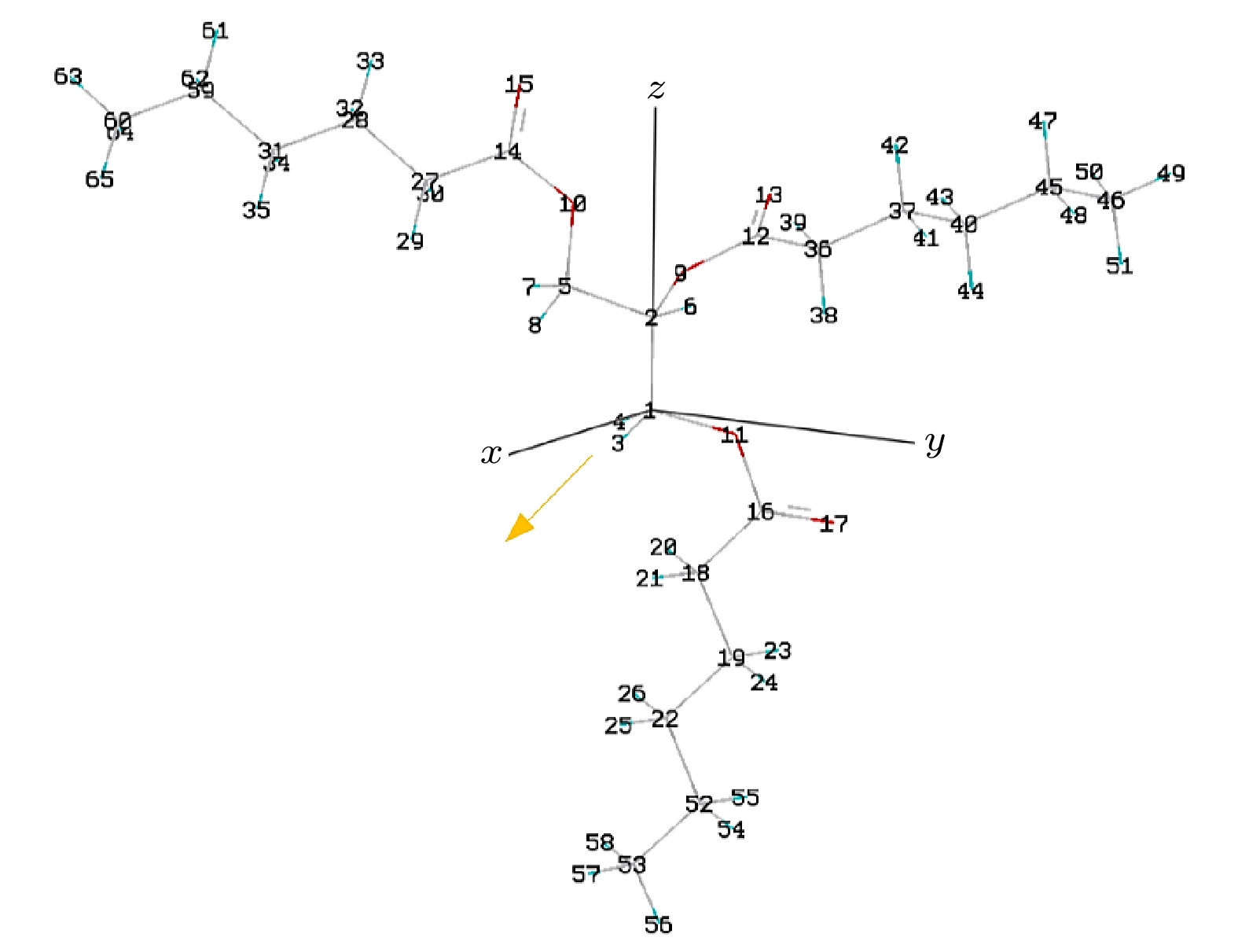
 DownLoad:
DownLoad:
